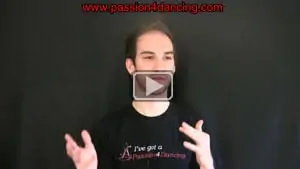Do you want to start dancing to the right beat of the music?
In this video I share 3 tips to help you. Let me know in the comments what you think.
New Musicality Course for Sale

Video Course (30-minutes)
Learn practical tips to dance “on time” to any song. In this 3-part video course you will learn step by step how I identify the beat in different songs. I play the songs right in front of you and show you how to find the beat and dance on time.
Order it now (click here)
Related:
Video podcast #2: Advice to ladies – Don’t reject guys…
Video podcast #1: A brief guide to dance practice
More video podcasts
Dance articles

Leon, thank for the information.
I think it would be more helpful if you demonstrate the tips with a music example. I know that’s more difficult, but for beginners it would be very helpful. Thank you anyway.
Hi Glenn,
That’s a good idea. I will consider doing a lesson with examples to music…
Thank you for the tips on how to dance alone it really helps me.
In Mambo the accented beat is 2 and 4, correct? Are there other dances that have the accented beat on a beat other than 1?
Chai,
Yes in the Mambo, we dance on counts 2 and 4, its not necessarily that the music will have the accent on 2 and 4 though…the more authentic mambo songs will.
More example, in International style Rumba, we dance on counts 4 and 2, but there could be an accent in the music on 1 as well.
Or in ChaCha we try to accent counts 1 and 3.
Thanks for the tips on counts. Of course they are very helpful but I agree with Glenn that demonstrating the count tips while the music plays would be a lot easier for learners to follow.
Thanks again
There were a few things there, that I hadn’t thought to use. Thanks for sharing.
Terrific points.. I will try it with the beats of music.
Very good topic. Like what you said, ‘a lot of people has problem with it’.
please provide more video and sample.
Beat of the music is most important steps
The only dances where the beat should be hard to find are some of the fast Latin dance. Foxtrot, Waltz, Tango, Bolero, Rumba, Cha-Cha, and Swing should be easy. Salsa, timba, mambo, etc., are more of a problem for two reasons. The tempo is fast and the bass line may not match the basic rhythm. A rumba or bolero has a basic bass line of half:quarter:quarter (a ration of 2:1:1, counted 1_2, 3, 4) whereas a salas may have very fast dotted-quarter:dotted-quarter:quarter (ratio 3:3:2, counted 1_2,&_3,4). “Blue Bayou” is a slow example; neither American nor English style rumbas step on the middle beat. Salsa or timba make make this even more complex by tying the last beat of one measure to the first beat of the next measure. The bass never has a downbeat in this style.
The piano does something different. The melody instruments (trumpets, etc.) which are loud enough to follow need not follow the beat (in this or any other dance for that matter.)
In Latin, the claves will indicate the beat, but they are often of low volume.
hi, i need to know if the merengue has an accent over the second E or any other place? and is there an accent mark over the dance movement called nanigo? tnx, allen
The accent in Merengue would be on count “1”. And all beats are equal beats.
Thanks Leon,you have given nice tips on beats n how to count one cos i m too fast while dancing n confused the counts, its my bigginers 5th Salsa class,but ur vedio clips find me very suitable nad easy to understand.i do practice with girl partners remembering your tips.
Hey Sunil…I am happy you like the tips. Welcome aboard and glad you enjoying the videos Sunil!
GREAT INFORMATION ,MUCH APPRECIATED . KEEP UP THE GOOD WORK
Normally in championship dancing at any dance we start from the second beat of the song, but eg: In the cha cha how do we know when to start dancing?( when the song starts does the beat also start) Give me some tips related to that
Hi Dhanushka,
Yes normally when the song starts the beat starts immediately so you will be able to find the beat.
I appreciate very much, for helping me understand where to locate beat and start dancing. Thank you.
Awesome tips! Thank you!
Thanks it helped
Thanks for the tips. I agree with Glenn that can we get the examples with different kinds of music
Thanks Leon for the tips…awaiting for more to come.
Thank you Leon for sharing these tips. It would help me a lot.
Maria
Thank you Leon! These tips really helped me find the beat and start on time..
Hi there! Wouldd you mind if I share your blog site with my twitter team?
There’s a bunch of individuals that I assume would really appreciate your material.
Please let me know. Manny thanks.
Thanks for the tips as to how to start dqncing on the first beqt of the music , I have a problem at times in picking up the first beat, my mind then to go blank in also remembering the figures to ezecut them, can you pleqse help me?
Thank you for the tips, it makes sense.
Leon. This video would not play at all. Getting an error message saying the server may be down
Everything works for me… Maybe you need to refresh your browser and try again.
Excellent Video, Leon – Tony Warnock’s comments in Sept 2011 added to the understanding.
Tes it would be nice to have eamples for each dance with accompanying music: will re-examine your other videos to improve my experience.
The start-of-song tip has been my only way, so far!
Thank, once again, Leon
The upbeat is the last beat in a measure of music prior to the downbeat. The downbeat is the first beat in a measure of music. (based on 4/4 time signature). There are many kinds of beats in various kinds of music. I have found that if I find the upbeat which is usually the most noticeable beat then I can easily find the downbeat which is immediately afterwards. Then I begin to say downbeat, upbeat, downbeat, upbeat. Sometimes the down beat is barely audible to the dancer, but if you find that upbeat first, the downbeat will appear in your brain even if you can’t distinctly hear it. I practice by listening to my music all the time. If you practice, continue saying down and up, down and up even throught the brakes in the music; if you come out “on beat” meaning the down beat, then you got it!!!
Leon. I disagree. My advice is to ignore the melody of the song, and listen only to the rhythm which is normally in the lower notes.
I see you don’t monetize your website, don’t waste your traffic, you can earn additional bucks every month because you’ve got high quality content.
If you want to know how to make extra bucks, search for:
Boorfe’s tips best adsense alternative
thank you for this article this helps me a lot
thank you for this information this is very helpful
None of these tips help. Often you need to find the first beat to the measures of music way way after the music has begun. The singers do NOT usually start singing on count 1—they frequently begin with one or more upbeats. There can be many strong beats in a measure and… HOW do you find the one which is Beat 1?
This is very, very, difficult to articulate. I read music. I play classical piano. My brother was trained as a lyric tenor. But neither of us can figure out WHAT *exactly* it IS that we are listening to when we find “1”.